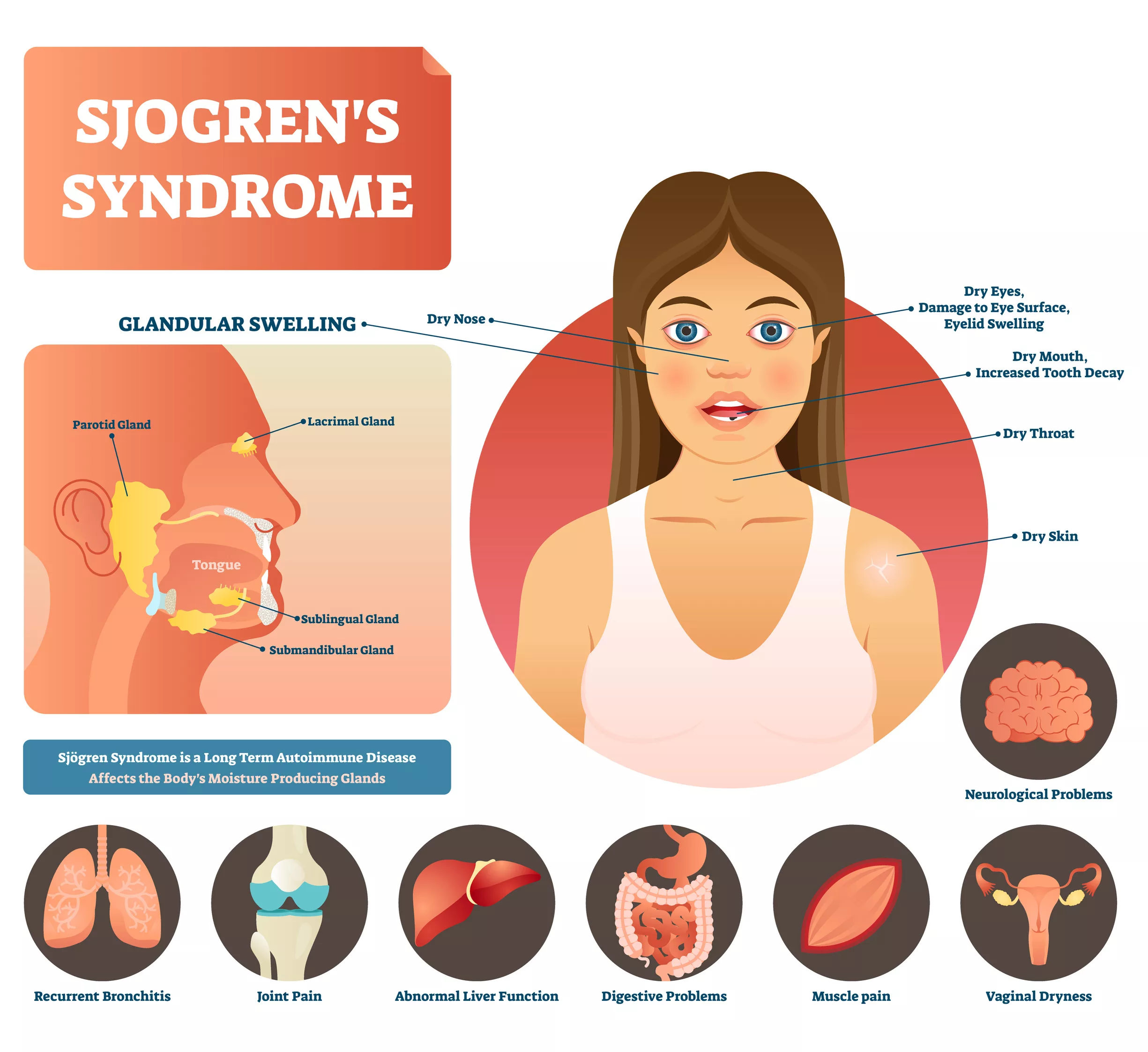Salivary gland disease refers to any condition that disrupts the normal function of the saliva-producing glands in the mouth and surrounding facial region. Saliva plays a vital role in lubricating the mouth and cleaning tooth surfaces by removing food debris. It is secreted by both major and minor salivary glands. The major glands—parotid, submandibular, and sublingual—produce the bulk of the saliva, while over 600 minor salivary glands are dispersed throughout the mucosal lining of the oral cavity and tongue. Saliva from these glands reaches the mouth through a network of ducts.1Pedersen, A. M. L., Sørensen, C. E., Proctor, G. B., Carpenter, G. H., & Ekström, J. (2018). Salivary secretion in health and disease. Journal of Oral Rehabilitation, 45(9), 730–746. https://doi.org/10.1111/joor.12664
What are Salivary Glands?
Salivary glands are saliva-secreting glands present inside the oral cavity or around the facial and neck region. The presence of infectious agents, blockade of a salivary duct due to salivary stone, and presence of tumor mass in the parenchyma (main body) of saliva salivary glands can hinder normal salivary function and create multiple problems in the patients. Such conditions come under the category of salivary gland disease.2Chisholm, D. M., & Mason, D. K. (1975). Salivary gland disease. British Medical Bulletin, 31(2), 156–158. https://doi.org/10.1093/oxfordjournals.bmb.a071272
Types of Salivary Gland Disease
Sometimes, problems arise in the glandular tissue or ductal pathways of the salivary glands, leading to decreased saliva production or flow. These conditions are grouped under salivary gland diseases. Some of the most commonly reported issues include the formation of stones in salivary ducts—called sialolithiasis—and infections of the glandular tissue, known as sialadenitis.3Chandrasekhar S. S. (2021). Salivary Gland Disease: A Comprehensive Resource. Otolaryngologic clinics of North America, 54(3), xiii–xiv. https://doi.org/10.1016/j.otc.2021.04.010
In other cases, the cells within these glands may start dividing uncontrollably, forming a tumor mass. This can be either benign or malignant. Regardless of the cause, salivary gland diseases can impact both the amount and quality of saliva, making everyday functions like chewing, speaking, and swallowing more difficult. Accurate diagnosis is important, especially to identify if a systemic illness or syndrome might be contributing to the gland dysfunction.
Common Salivary Gland Diseases
Following are some of the most common salivary gland diseases:
Sialolithiasis:
Sialolithiasis is a salivary gland disease in which a mineralized mass, or stone, gets stuck in the salivary duct—most commonly in the duct of the submandibular gland. These stones vary in size and composition.4Beneng K. (2022). Obstructive salivary gland disease. Primary Dental Journal, 11(3), 82–87. https://doi.org/10.1177/20501684221117199 The obstruction leads to reduced saliva flow and often causes pain and swelling, particularly during meals, when saliva production naturally increases.
Sialadenitis:
Sialadenitis is an inflammatory condition of the salivary glands caused by microbial infection. The most common viral infections affecting salivary glands are mumps and cytomegalovirus infections. In this condition, patients develop unilateral or bilateral swelling. Bacterial sialadenitis, typically caused by Staphylococcus aureus, can result in painful swelling, high fever, and systemic symptoms like malaise. These infectious can cause potential complications in the patients if not treated properly on time.5Delli, K., Spijkervet, F. K., & Vissink, A. (2014). Salivary gland diseases: infections, sialolithiasis, and mucoceles. Monographs in oral science, 24, 135–148. https://doi.org/10.1159/000358794

Salivary Gland Tumors:
Most tumors develop in the parotid gland and are typically benign, but malignancies like adenoid cystic carcinoma can occur, especially in minor salivary glands. These cancers can grow slowly but are known for their aggressive nature and potential to spread along nerves. The most common symptom of a salivary gland tumor is the presence of painless swelling in the facial region. All these tumors require immediate treatment options in the form of chemotherapy or surgical removal of the gland to prevent the spread of tumor mass into another area.6Guzzo, M., Locati, L. D., Prott, F. J., Gatta, G., McGurk, M., & Licitra, L. (2010). Major and minor salivary gland tumors. Critical reviews in oncology/hematology, 74(2), 134–148. https://doi.org/10.1016/j.critrevonc.2009.10.004
Sjogren Syndrome:
Sjögren syndrome is a chronic autoimmune disorder that primarily affects the salivary and lacrimal glands. It leads to reduced function of moisture-producing glands, resulting in dry mouth (xerostomia) and dry eyes (xerophthalmia). It may occur as an isolated condition (primary Sjogren) or alongside other autoimmune diseases like rheumatoid arthritis (secondary Sjogren).

Causes of Salivary Gland Disease
The following are the major causes of salivary gland diseases:
Infectious Agent:
The most common cause of salivary gland disease is the presence of infectious agents, for instance, streptococcus and staphylococcus bacteria, or viral agents like echovirus, coxsackie virus, mumps virus, flu virus, and cytomegalovirus are the most common.
Intake of certain Medications:
Patients who are taking medications like antihistamines for allergic reactions, drugs for high blood pressure, and psychological problems might develop salivary gland problems due to decreased saliva secretion.7Jensen, S. B., Vissink, A., Limesand, K. H., & Reyland, M. E. (2019). Salivary Gland Hypofunction and Xerostomia in Head and Neck Radiation Patients. Journal of the National Cancer Institute. Monographs, 2019(53), lgz016. https://doi.org/10.1093/jncimonographs/lgz016
Autoimmune Disorders:
Certain autoimmune conditions can cause damage to salivary glands, like in Sjogren syndrome, in which immune cells of the body, mainly white blood cells, start destroying healthy cells of salivary glands and tear-producing glands.
Tumor Mass:
The presence of tumor mass can occur due to genetic factors like family history and environmental factors like increased exposure to sunlight, chronic smoking, or betel nut chewing.
Parafunctional Habits:
Any habit that decreases the amount of saliva in the oral cavity can cause salivary gland disorder. The most common habits include prolonged smoking, chewing betel nuts, prolonged dehydration which lowers saliva production, and prolonged fasting which decreases saliva amount in the mouth.
Risk Factors for Salivary Gland Disease
The most common risk factors associated with salivary gland diseases are:
- Radiation exposure to treat cancer in the area of the head and neck region.
- Chronic smoking is particularly linked to an increased risk of benign tumors like Warthin’s tumor.
- Eating disorders that disturb the nutritional balance of the body.
- Intake of medicines like antihistamines, and psychiatric medications.
- The presence of chronic inflammation and longstanding infection in the body.
Clinical symptoms of Salivary Gland Disease
The most common symptoms that appear in patients with salivary gland diseases are:
Blockade of Salivary Gland Ducts:
A blocked duct due to a salivary stone (sialolith) can lead to a lump under the tongue or near the jaw. This often becomes painful during meals, when saliva production increases.
Infectious Disease of the Salivary Glands:
Infection may cause unilateral or bilateral swelling, typically around the cheek or under the chin. The affected area is often tender to the touch. Patients may experience high-grade fever and malaise. In severe bacterial infections, pus may drain into the mouth due to mucosal thinning. In some viral cases, such as mumps, the swelling may become prominent and extend toward the area in front of the ears and under the eyes.8Thomas, B. L., Brown, J. E., & McGurk, M. (2010). Salivary gland disease. Frontiers of oral biology, 14, 129–146. https://doi.org/10.1159/000313711
Salivary Tumor:
A painless mobile lump appears in the cheek, palate, under the surface of the tongue, and chin area. The growth rate of salivary gland tumors is quite low. However, a few malignant tumors may grow more rapidly and become painful, especially if they invade nerves.
Sjogren Syndrome:
Patients experience dry mouth and dry eyes. Reduced saliva impairs natural oral cleansing, increasing the risk of dental caries and difficulty speaking or swallowing.
Diagnosing Salivary Gland Disorders
The following tests can be conducted to diagnose salivary gland diseases:
- General Physical Examination
- Palpation
- Ultrasound for parotid gland swellings
- Incisional and excisional biopsy
- FNAC
- Antibody testing, for instance, SS-A & SS-B for Sjogren’s Syndrome
- Sialometry
- Sialography
Treatment of Salivary Gland Disease
Treatments of various salivary gland diseases are stated next:
Removal of Stone:
Treatment depends on the location and size of the stone. If the stone is near the duct opening, it may be removed with special instruments. Larger or deeper stones may require surgical removal or lithotripsy (ultrasound-based stone fragmentation). In rare cases, the entire gland may need to be removed.
Bacterial & Viral Infection:
Bacterial infections require proper treatment with antibiotics, while viral infections like mumps are managed supportively. In some cases, surgical drainage may be required to relieve abscesses or pressure caused by pus accumulation.
Salivary Tumors:
A small mass can be treated with the help of radiation therapy. In the case of a cancerous tumor, surgery to remove the gland (like parotidectomy, the removal of the parotid gland) along with chemotherapy is needed to save the nearby tissues.
Take-Home Message
To sum it up, salivary gland disease requires prompt and proper treatment according to the nature of the disease and causative agent. Early diagnosis and management help relieve symptoms, prevent complications, and restore normal gland function, allowing patients to enjoy better oral and overall health.
Refrences
- 1Pedersen, A. M. L., Sørensen, C. E., Proctor, G. B., Carpenter, G. H., & Ekström, J. (2018). Salivary secretion in health and disease. Journal of Oral Rehabilitation, 45(9), 730–746. https://doi.org/10.1111/joor.12664
- 2Chisholm, D. M., & Mason, D. K. (1975). Salivary gland disease. British Medical Bulletin, 31(2), 156–158. https://doi.org/10.1093/oxfordjournals.bmb.a071272
- 3Chandrasekhar S. S. (2021). Salivary Gland Disease: A Comprehensive Resource. Otolaryngologic clinics of North America, 54(3), xiii–xiv. https://doi.org/10.1016/j.otc.2021.04.010
- 4Beneng K. (2022). Obstructive salivary gland disease. Primary Dental Journal, 11(3), 82–87. https://doi.org/10.1177/20501684221117199
- 5Delli, K., Spijkervet, F. K., & Vissink, A. (2014). Salivary gland diseases: infections, sialolithiasis, and mucoceles. Monographs in oral science, 24, 135–148. https://doi.org/10.1159/000358794
- 6Guzzo, M., Locati, L. D., Prott, F. J., Gatta, G., McGurk, M., & Licitra, L. (2010). Major and minor salivary gland tumors. Critical reviews in oncology/hematology, 74(2), 134–148. https://doi.org/10.1016/j.critrevonc.2009.10.004
- 7Jensen, S. B., Vissink, A., Limesand, K. H., & Reyland, M. E. (2019). Salivary Gland Hypofunction and Xerostomia in Head and Neck Radiation Patients. Journal of the National Cancer Institute. Monographs, 2019(53), lgz016. https://doi.org/10.1093/jncimonographs/lgz016
- 8Thomas, B. L., Brown, J. E., & McGurk, M. (2010). Salivary gland disease. Frontiers of oral biology, 14, 129–146. https://doi.org/10.1159/000313711

